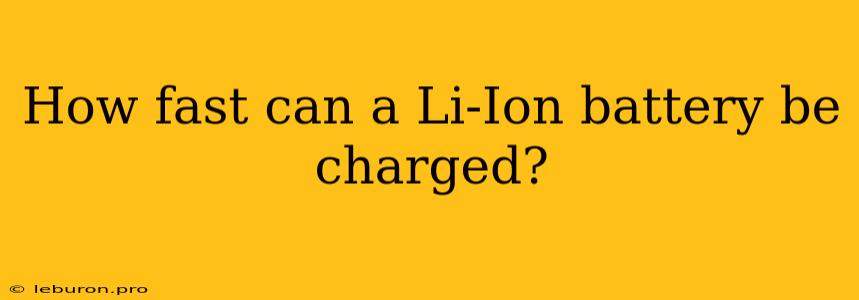Lithium-ion batteries, ubiquitous in modern devices from smartphones to electric vehicles, have become integral to our daily lives. Their widespread adoption is driven by their high energy density, long lifespan, and impressive performance. However, the speed at which these batteries can be charged remains a crucial factor influencing user experience and overall efficiency. This article delves into the factors governing Li-ion battery charging speeds, exploring the limitations, advancements, and future trends in this field.
Factors Influencing Li-Ion Battery Charging Speed
Several factors influence how quickly a Li-ion battery can be charged. These include:
1. Battery Chemistry and Design:
The inherent chemical properties of the battery materials play a critical role. Li-ion battery chemistries, such as lithium cobalt oxide (LCO), lithium manganese oxide (LMO), and lithium iron phosphate (LFP), exhibit varying charge acceptance rates. LFP batteries, for instance, can handle faster charging rates than LCO batteries due to their superior structural stability. Additionally, the internal structure of the battery, including the electrode materials, electrolyte, and separator, impacts charging speed.
2. Charging Current and Voltage:
The amount of electrical current flowing into the battery during charging directly affects the charging rate. Higher currents lead to faster charging but can also generate heat and stress within the battery, potentially impacting its lifespan. The charging voltage also plays a crucial role, as it dictates the potential difference driving the charging process.
3. Temperature:
Temperature significantly affects the charging speed and safety of Li-ion batteries. Charging at very low or very high temperatures can result in slower charging rates and even damage the battery. Optimum charging temperatures are typically around 25°C (77°F).
4. State of Charge (SOC):
A battery's state of charge, representing the amount of energy stored, influences charging speed. Charging a battery from a low SOC to a high SOC typically takes longer than charging from a higher SOC to a full charge.
5. Battery Age and Degradation:
As Li-ion batteries age, their internal resistance increases, resulting in slower charging rates. Degradation, stemming from repeated charging and discharging cycles, can further reduce the battery's capacity and charging speed.
Fast Charging Technologies for Li-ion Batteries
Driven by the demand for faster charging solutions, researchers and engineers are developing various technologies to overcome the limitations of traditional Li-ion battery charging. These include:
1. Fast Charging Protocols:
Industry standards like Quick Charge (Qualcomm), USB Power Delivery (USB-PD), and SuperVOOC (Oppo) enable faster charging by increasing the voltage and current supplied to the battery.
2. Pre-Heating and Cooling Systems:
Maintaining the battery temperature within an optimal range can significantly improve charging speed and safety. Pre-heating the battery before charging and employing cooling systems during charging can enhance performance.
3. Pulse Charging:
This technique involves applying short pulses of high current followed by periods of rest to minimize heat generation and improve charging efficiency.
4. Advanced Battery Chemistries:
New battery chemistries, such as lithium nickel manganese cobalt oxide (NMC) and lithium titanate oxide (LTO), are being developed to achieve faster charging rates while maintaining high energy density and long lifespan.
Limitations and Challenges of Fast Charging
While fast charging offers undeniable benefits, it also poses challenges:
1. Battery Degradation:
Fast charging can lead to accelerated battery degradation, reducing its lifespan and overall performance.
2. Safety Concerns:
High charging currents can generate significant heat, increasing the risk of thermal runaway and potential hazards.
3. Cost:
Fast charging technologies often involve additional components and sophisticated circuitry, potentially increasing the cost of the battery system.
The Future of Li-ion Battery Charging
The pursuit of even faster charging speeds continues, with researchers exploring innovative approaches:
1. Solid-State Batteries:
Solid-state batteries, replacing the liquid electrolyte with a solid material, promise faster charging rates and improved safety.
2. Micro-Supercapacitors:
These devices can store and release energy much faster than conventional batteries, offering a potential solution for ultra-fast charging applications.
3. Advanced Charging Algorithms:
Sophisticated algorithms are being developed to optimize charging profiles and minimize degradation while maximizing charging speed.
Conclusion
The speed at which Li-ion batteries can be charged is a critical factor influencing user experience and overall efficiency. While advancements in battery chemistry, charging technologies, and protocols have enabled faster charging rates, limitations and challenges remain. The future of Li-ion battery charging lies in innovative solutions that balance speed, safety, and longevity, ensuring a seamless and sustainable experience for users across various applications. As the demand for faster charging continues to rise, research and development in this field will be instrumental in shaping the future of energy storage and utilization.
